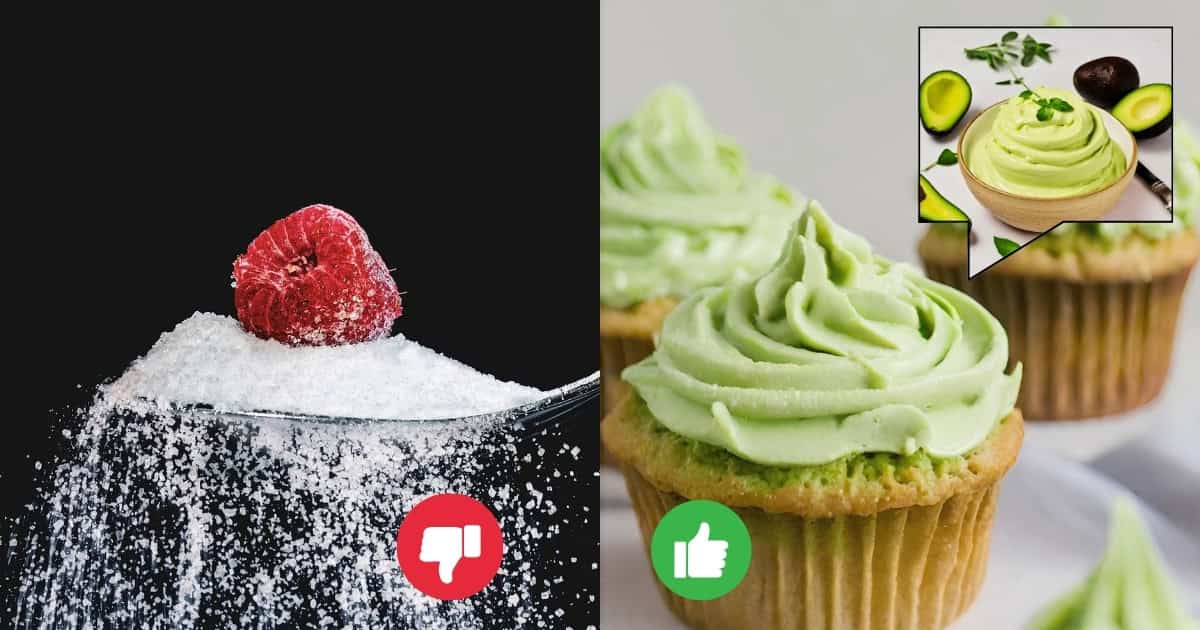Last Updated on May 3, 2024 by Our Editors
Cupcakes are more than just a treat—they’re a source of joy, whether it’s a mid-day pick-me-up or the sweet end to a meal. But who wants to deal with the dreaded sugar spike that often accompanies them? Nope, not us.
Let’s come together and wave goodbye to the sugar-induced rollercoaster by incorporating an entire range of inventive, delicious, and health-conscious sugar alternatives for our frostings.
Believe it or not, you can whip up frosting without powdered sugar, and we’re here to guide you through it. Let’s get started.
Why Try Out The Sugar-Free Frosting Alternatives?

Every day, millions of people make a choice between dodging a potential spike in glucose levels and indulging in a delightful treat. Having a bunch of sugar alternatives to go can help them get rid of this decision fatigure.
Seeking out sugar alternatives isn’t just following the latest trend; it’s a transformative habit that should be part of your daily routine. We’re all too aware of the downsides of sugar overload—it’s linked to a slew of health issues like obesity, diabetes, and heart disease.
Swapping out regular sugar for natural goodies like honey, maple syrup, or stevia not only cuts down on the bad stuff but also sneaks in some extra nutrients and antioxidants. Plus, it opens up a world of possibilities for folks with specific dietary needs or preferences. Win-win, right?
Frosting Without Powdered Sugar: 4 Healthier Alternatives
Frosting is synonymous with traditional sugar. However, making frosting without powdered sugar is possible. Here are four healthy alternatives that you can start using right away.
1) Cream Cheese Frosting with Honey or Maple Syrup

Cream cheese frosting is a beloved classic, known for its creamy texture and tangy flavor. When sweetened with honey or maple syrup instead of powdered sugar, it becomes a deliciously indulgent treat without the refined sugars.
How to Make It:
Create this yummy creamy frosting by whipping together 8 oz of softened cream cheese, 1/4 cup of honey or maple syrup, and 1 tsp of vanilla extract until smooth.
Adjust the sweetness to your liking and chill the frosting before use. To ensure the perfect consistency, remember to keep the cream cheese at room temperature and avoid overmixing. Experiment with flavor variations like lemon zest, cinnamon, or mashed berries, and pair this indulgent frosting with classics like carrot cake, red velvet cupcakes, or slices of warm banana bread for a delightful treat.
2) Vegan Coconut Buttercream with Agave Nectar

Vegan coconut buttercream with agave nectar is a plant-based frosting option that is both delicious and dairy-free. It’s made using coconut oil or coconut butter as the base, which provides a rich and creamy texture. Agave nectar, derived from the agave plant, serves as a natural sweetener, offering a subtle sweetness without the need for refined sugar.
How To Make It:
To make vegan coconut buttercream with agave nectar, start by creaming together softened coconut oil or coconut butter with agave nectar until smooth. You can then add flavors such as vanilla extract or coconut extract to enhance the taste.
This frosting can be used to decorate cakes, cupcakes, or cookies, providing a luscious and vegan-friendly topping option for those with dietary restrictions or preferences.
3) Avocado Chocolate Frosting with Date Syrup

Avocado chocolate frosting is a dairy-free option that uses ripe avocados as the base, and offers a creamy combination of protein and fats to your desserts. Date syrup, made from dates, serve as a natural sweetener here, and add a rich caramel-like sweetness to the frosting without the need for refined sugar.
How To Make It:
To prepare avocado chocolate frosting with date syrup, you typically blend ripe avocados with cocoa powder, date syrup, and a splash of vanilla extract until smooth and creamy. The result is a decadent and silky frosting that pairs well with a variety of baked goods, including cakes, cupcakes, and brownies.
Not only does this frosting offer a unique flavor profile, but it also provides nutritional benefits from the avocado and dates, making it a guilt-free indulgence for chocolate lovers.
4) Greek Yogurt Frosting with Fruit Puree

Greek yogurt frosting with fruit puree is a tangy and refreshing twist on traditional frosting. By incorporating Greek yogurt, you infuse the frosting with protein and a creamy texture, while the fruit puree adds natural sweetness and vibrant flavor.
How to Make It:
Mix Greek yogurt with your choice of fruit puree, such as strawberry, raspberry, or mango. Later, adjust the amount of puree based on your desired level of sweetness and fruit flavor intensity. Add a touch of honey or maple syrup for enhanced sweetness.
Once blended to a smooth consistency, spread the frosting onto cakes, cupcakes, or cookies. It’s a lighter option compared to buttercream frostings. Plus, the addition of fruit puree adds a burst of color and fruity goodness, making this frosting both visually appealing and delicious.
How To Nail Your Frosting Without Powdered Sugar
Something you need to understand sugar is that it’s so much more a sweetener. Sugar is a binding agent, and it plays multiple roles in baking and emulsification. While sugar can be replaced with alternative sweeteners in baking, it’s important to consider the impact on texture, moisture, and overall baking chemistry.
Here are three things that you need to keep in mind before trying out sugar-free alternatives in your home recipes:
Base: When you’re trying to make sugar free frosting at home, start with a creamy foundation, such as mashed avocado or Greek yogurt. To enhance the taste, use natural sweeteners like monk fruit or stevia. You can also add a small amount of honey or maple syrup to boost that delectable, sugar-like flavor.
Taste: Additions such as vanilla extract for a traditional taste or cocoa powder for a chocolatey kick can enhance the flavor. Gradually add dairy-free milk until it reaches the perfect spreadable texture to get the required consistency.
Texture: To ensure the frosting sets completely and reaches its maximum potential, don’t forget to chill it before using it.
Do read: The sweet danger of sugar to better understand the adverse effects of powdered sugar.
Is Going Sugar Free An Ethical Choice To Make?

Making frosting without powdered sugar has several advantages for sustainability. As per Panda Org., about 145 million tonnes of sugar is annually consumed worldwide. This takes a heavy toll on the planet. By avoiding highly processed products, lessens its impact on the environment by using less energy and emitting fewer emissions.
Choosing natural sweeteners like maple syrup or honey promotes sustainable farming methods in the area and helps preserve biodiversity. Opting for frosting without powdered sugar also reduces packaging waste and the environmental impact.
At Ecowiser, we wholeheartedly believe that using natural sweeteners is way better than gouging on sugar, and that it also makes a better frosting. Although we are talking about fluffy desserts, we must keep in mind that accepting a range of sweeteners promotes culinary and agricultural diversity, which strengthens resistance to environmental shocks. Bummer, we know! But we must prepare for the world we’re escalating towards every day.
Storage and Shelf-Life Considerations For Frosting Alternatives

While traditional frosting made with powdered sugar tends to have a longer shelf life due to its high sugar content, frosting without sugar requires a bit more attention to storage and shelf life. To preserve the freshness and texture of your frosting alternatives, store them in an airtight container in the refrigerator.
💡 Most frosting alternatives will last for up to a week when refrigerated, but be sure to check for any signs of spoilage, such as changes in color or texture, before using. If you need to extend the shelf life, you can freeze frosting in an airtight container for up to three months. Just be sure to thaw it in the refrigerator overnight before using and give it a quick stir to restore its creamy consistency.
Make These Healthy Swaps For A Long Life!
When you go for frosting without powdered sugar, you’re not just doing yourself a favor, but are also thinking about the larger picture. Stepping away from refined sugars that often come from not-so-friendly farming methods is a smart choice to make every single day.
Plus, you’re supporting sustainable agriculture and cutting down on your kitchen’s carbon footprint. It’s like hitting two birds with one stone! And hey, experimenting with different ingredients? That’s just expanding your culinary game and finding all sorts of tasty surprises!
At Ecowiser, we keep our readers up to date with Eco-Nourish products and practises that are healthy and in-style. Check it out right here.
Frequently Asked Questions (FAQs)
Is the texture and consistency of frosting alternatives same as powdered sugar?
While frosting alternatives may have a slightly different texture and consistency compared to traditional powdered sugar frosting, with careful ingredient selection and experimentation, you can achieve similar results. Adjusting the ratios of ingredients and incorporating natural thickeners can help you achieve the desired texture and spreadability.
How to store frosting without powdered sugar?
Frosting without powdered sugar should be stored in an airtight container in the refrigerator to maintain freshness and prevent spoilage. Depending on the ingredients used, frosting alternatives may have a shorter shelf life compared to traditional frosting. Be sure to check for any signs of spoilage, such as changes in color or texture, before using.
Are frosting alternatives healthier than powdered sugar frosting?
Frosting alternatives can be considered healthier than powdered sugar frosting, as they often use natural sweeteners and ingredients with additional nutritional benefits. By avoiding refined sugars, frosting alternatives may have a lower glycemic index and fewer empty calories. However, moderation is still key, as even natural sweeteners should be consumed in moderation as part of a balanced diet.















